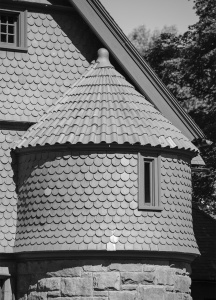Norfolk Library Plans for the Next Century
Preserving an Architectural Gem
By Ruth Melville
The Norfolk Library is one of the architectural highlights of our town. For over 125 years this striking building on the Village Green has served the people of Norfolk, not only as a home for books, but as a gathering place for town residents. The library recently received the highest, five-star rating from Library Journal, one of only two libraries in the state to be so honored.
Taking care of this building is a charge that successive trustees of the library have been proud to take on.

This turret is one of the last parts of the building to keep its original red-clay Spanish roof tiles. Photo by Christopher Little.
Keller adapted elements of the Romanesque, Queen Anne, and Gothic Revival styles in his design. For materials, he used primarily red stone from East Longmeadow, Mass., to face the first floor, and fish-scale terra cotta tiles on the second. Originally, the roof was made of Spanish tiles, but over time they was replaced with asphalt tiles. You can still see some of the roof tiles, though, on the top of the turret near the entrance.
Other distinctive features of the building are the stained glass windows in the reference room and main hall, and the owl-shaped gargoyle on the front porch. Another stone owl stands over the fireplace. It holds a book with the library’s motto Inter Folia Fructus, “Fruit among the leaves” (or, more prosaically, knowledge among the pages) on the cover. The same motto appears on the ceiling of the Thomas Jefferson Building of the Library of Congress.
Unsurprisingly, time and environmental wear and tear have taken their toll on the library. Several years ago, the library trustees noticed that the stone was stained and in need of some repair work. In 2012 they hired John G. Waite Associates, Architects, who specialize in historical preservation and had already done work for the Norfolk Country Club and the Battell Stoeckel Estate, to do an assessment of the condition of the building’s exterior.
In general, the Waite report found, the building has aged well, largely because it was originally built with high-quality materials. The replacement asphalt roof is starting to wear, however, and there are areas of deterioration in the stonework, particularly around the entrance. A lot of the latter damage has been caused by water runoff from Route 44. Repeated repaving has raised the level of the road outside the library, which causes water to drain toward the building, not away from it. In the fall of 2013, a representative of the Connecticut Department of Transportation (DOT) came to the site to discuss options for ameliorating the drainage issue. These discussions are ongoing, but in the end the library is responsible for water issues around its building.
During the repaving last summer, the state installed an asphalt curb that actually worsened the problem, directing water not toward the newly installed storm drain but toward the library. Once alerted to the problem, however, the DOT was quick to correct the mistake. The library hopes someday to replace this asphalt curb with a granite one, in keeping with the other curbing around the Village Green.
To undertake needed repairs and cleaning of the building, and to continue to improve the drainage problem, the library has applied for a Historic Restoration Fund Grant from the state’s Department of Economic and Community Development. The trustees will find out in early January 2015 whether their application has been successful. The goal is to ensure the continued beauty of this Norfolk jewel for the next 125 years.
